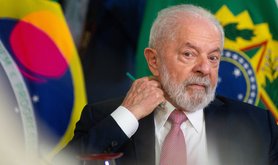
Chile’s constitutional moment: history in the making

28 days after the outbreak of the first protests over a rise of 30 pesos (the equivalent of 0.03GBP) for subway tickets, lawmakers and leaders of almost every political faction presented a historic agreement, announcing a referendum on a new constitutional process. How can a 3% fare increase so fundamentally shake up a supposedly stable and prosperous country and turn into a veritable constitutional revolution?
Commentators explained how Chile’s macroeconomic success story obscured deeper socio-economic and political rifts running through Chilean society. While the combined wealth of Chile’s billionaires is equal to nearly 25% of the country’s GDP, its rising middle class is highly indebted and struggles to stay afloat in the face of the high costs for part-privatized education and health systems, rents and utilities, and unreliable and meagre pensions.
Some highlighted the political fault lines in the country: political power is heavily concentrated among the economic elite, creating a widespread sense of political disenfranchisement among Chileans. Mistrust of political parties and institutions was further fuelled by congressional gridlock and corruption scandals across the political spectrum.
The ongoing protests are the culmination of longstanding discontent. Tensions have been simmering for years. Frustrations over different aspects of inequality, health, pensions, education, and other issues, have been the individual subjects of periodic demonstrations over the last decade. Chile’s ongoing “30 pesos revolution”, as it is beginning to be dubbed, is not about “30 pesos, it is about 30 years of abuse of power”, as protesters scan.
We’ve got a newsletter for everyone
Whatever you’re interested in, there’s a free openDemocracy newsletter for you.
Very early on, the protests were geared against the 1980 Constitution, through which Pinochet firmly anchored a market-oriented politico-economic model in Chile’s political system. Indeed, many of Chile’s interlocked socio-economic and political imbalances are rooted in this constitution.
Pinochet’s long shadow
Arguably, the agreement between Pinochet and the opposition to keep Chile’s 1980 constitution – albeit in amended form - beyond Pinochet’s abdication was the foundation for Chile’s much celebrated peaceful transition to democracy in 1990 and the guarantor for medium-term stability and prosperity. But the constitution also prevented the long-term structural translation of Chile’s economic success into a distributional welfare state and constrained the development of a fully-fledged democracy in the long term.
The architect of the 1980 Constitution, Jaime Guzmán, had constructed solid legal-institutional dykes that firmly cemented the regime’s neo-liberal socio-economic and political vision beyond the end of the dictatorship. A stifling “binomial” electoral system effectively created a two-party system which was, for a long time, dominated by centre-left and centre-right coalitions and excluded minority parties from political participation; numerous high-quorum and supra-majoritarian requirements for the amendment of the constitution and its “organic constitutional laws”, dealing with issues such as the education system, the electoral system, and the Constitutional Court, effectively equipped a political minority with a veto-power - including the political heirs of the dictatorship; finally, the predominantly conservative Constitutional Court was equipped with wide-reaching powers to pre-emptively strike out provisions it deemed unconstitutional while they were being discussed in Congress.
Political reforms were not resolved via party-based deliberation, elections, or legislative debates, but via closed-door negotiations among the political elite.
These "authoritarian enclaves” fostered the ‘politica de los acuerdos’, consensus-finding between the centre-right and centre-left that marked post-Pinochet decision-making. Political reforms were not resolved via party-based deliberation, elections, or legislative debates, but via closed-door negotiations among the political elite. This system brought political stability, but at the cost of fundamental socio-economic reform and democratic representation.
Since the end of the dictatorship, Pinochet’s “authoritarian enclaves” were gradually dismantled. Chile’s constitution was amended in a piece-meal fashion over 30 times, removing most of the dictatorship’s legal legacy: the constitution’s most grossly authoritarian sections of the constitution were abolished, the powers of the branches of government were reformed, and finally, the binomial (or binominal) electoral system was replaced by a system of proportional representation – crucially, the supermajority requirements for constitutional reform remained in place.
While these reforms substantially and structurally changed the constitution’s form, they were achieved with minimal public input and were the outcome of high-level negotiations between the traditional political elite. As a result, political institutions remained more conservative than Chile’s society and multiple socio-economic reforms (including tax reforms, education reforms etc.) never fully addressed the grievances of many people. Unsurprisingly, the constitution thus never gained substantive legitimacy in the eyes of the public. Many Chileans still see the constitution as “Pinochet’s” constitution.
Bachelet’s failed attempt for constitutional overhaul
Since 2006 onwards the political climate became increasingly opposed to the tendency of post-Pinochet politicians to privilege political stability and economic growth over addressing distributional conflicts and social demands. Prior to the 2013 presidential elections, a movement called on voters to mark their ballots with a “AC” (Assamblea Constituyente), signalling their demand for the invocation of a constituent assembly outside of the existing institutional framework to draft a new constitution. Roughly 1 in 10 voters marked their votes accordingly.
President Michelle Bachelet won the elections and took office in a left-wing coalition called Nueva Mayoria, with the aspiration of tackling not only the political-economic model (e.g. via tax and education reforms), but also the last remnants of the institutional legacy of the dictatorship. In 2015, Bachelet launched an ambitious and highly participatory and inclusive constitution-making process to replace the 1980 constitution. For the first time, Chile’s citizens were directly involved in a national reform via an innovative process, which included citizen meetings across the nation via self-organised local assemblies called “encuentros locales auto-convocados” or “cabildos”.
However, the process hit a wall with the political customs that had marked Chile’s politics since its transition. Conservative and right-wing politicians generally doubted the need for a constitutional change, noting that almost all of Pinochet’s “enclaves” had been eradicated. In the absence of any cross-party agreement on the mechanism of a constitutional change (e.g. via a constituent assembly, or the parliament), centre-left politicians did not see any realistic opportunity to jump the hurdles of the constitutional supermajorities. Finally, the momentum for constitutional change dwindled when – in stark contrast to the broad and public beginning of the process - the final text was drafted behind closed doors. Political leaders from all sides felt alienated, calling the process biased and a “scam”, and many Chileans felt discouraged and disappointed.
Success and failure will depend on the government’s ability to channel the unrest into a meaningful constitutional reform process.
Returning to the traditional script of the “grandes acuerdos”, Bachelet’s conservative successor Piñera shelved the constitutional draft and ended the debate around a new constitution, instead proposing an institutional reform process that privileged problem-solving and effective governance over representation and democratic consolidation. The question of constitutional change went dormant.
Constitutional sea change
In the wake of the ongoing unrest, the traditional logics of Chile’s political landscape appear to be shifting. Sebastián Piñera’s initial attempts to appease protestors by reshuffling his cabinet and promising a new rounds of major policy reforms have been in vain. His abyssal support rates and an unprecedented wave of support for constitutional change among a wide spectrum of political parties as well as the two branches of the government, including the judiciary, finally pushed President Piñera to agree to a new constitution-making process.
Success and failure will depend on the government’s ability to channel the unrest into a meaningful constitutional reform process. Chile’s last, and highly participatory constitution-making attempt has clearly left an imprint on the citizens - Chileans throughout the country and abroad have revived the cabildos that were part of the previous constitution-making process to discuss what a future Chile could look like. It appears as if politicians are sensing that the old tradition of the “grandes acuerdos” alone will not do the trick this time.
In April 2020, Chileans will vote on whether they want a new constitution or not and what form the constitution-making body will take – in any case, if the Chilean public opts for constitutional renewal, negotiations will not take place within the traditional institutions, but in a specially elected constitutional convention.
While many details of the process remain unclear and a constitution is never a panacea, the protests opened up a historical opportunity for stepping out of Pinochet’s long shadow and move towards a more equitable society.
Read more
Get our weekly email




Comments
We encourage anyone to comment, please consult the oD commenting guidelines if you have any questions.